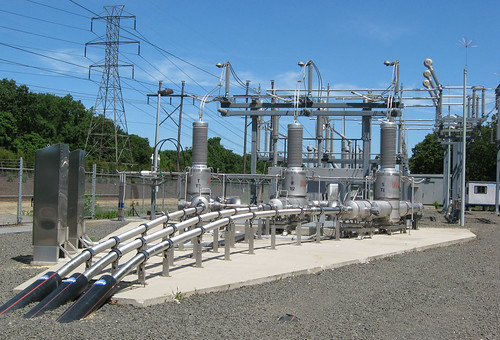Lynne Kiesling
Over the past six years here at KP I’ve discussed the development of high-temperature superconductor technologies and their application to electric power systems, and today we have reached a milestone in that development:
Power executives, engineers, and the media gathered recently to officially throw the switch at the $60 million Holbrook Superconductor project, the world’s first transmission power cable transmitting waves of electricity from the grid to a substation that feeds actual U.S. homes.
This project, using American Superconductor technology, involves 99 miles of 138 kV high-temperature superconductor lines that are cooled cryogenically using liquid nitrogen. It transmits power via 6 outdoor connectors to the Long Island Power Authority’s customers. LIPA’s Ken Law stated the significance of this development well:
Law, who joined the officials celebrating the launch of the Holbrook Superconductor project after two years of construction, pointed out that much of the technology in the grid hasn’t had a major upgrade since Dwight Eisenhower lived in the White House in the 1950s.
“We have a high-tech economy but we have a low-tech electrical grid,” Law said. “We need to bring our electrical grid into the 21st century. Our system here is about 60 years old. And just like in any area, technology is improving on a daily basis.”
Law said the superconductors offer the opportunity to transmit on lines that take up much less space and hold much more power.
Transmission lines that take up less space and have fewer line losses economize on a resource that will only get more and more scarce over time, because of its fixed supply: space. Right now, transmission rights of way take up wide swathes of land, and on average transmission wires lose 7-8% of the power they transmit (UPDATE: Ed correctly corrects me in the comments; transmission losses are closer to 1%). Economizing on land use and reducing line losses will be substantial value propositions for technologies like this, even though they cost more because of the materials and the cooling requirements.
For further information, see a video on the project, American Superconductor’s press release, and their FAQ on the project.

Lynne,
I believe transmission losses are closer to 1%. Distribution losses are in the 7% range on average, though they can double on peak.
Lynne-
One thing I can’t get a handle on from the links — is this project actually economic, or is it being subsidized as a technology demonstrator. In other words, do the reduced line losses and other benefits have a nigher NPV than the increased capital cost plus the ongoing cost of refrigeration. In particular, it strikes me that liquid nitrogen is relatively expensive to make and would eat up a lot of the electricity savings
There is confusion in this article. The implication is that the superconducting line is 99 miles long. However the other references indicate a length of 2000 ft which makes a lot more sense. In any case you would not have a 99 mile long AC cable because of other factors. You could have 5 20 mile sections with compensation between sections.
It is, at present, a technology demonstrator. The savings in losses do not make up for the cost associated with refrigeration etc.
However, considering the costs of right of way in cities or even Long Island, going this way may be the best economic choice.
Electric Wheelchairs
Actually, the vanguard for electric scooters & other green transportation in the US for over fifteen years has been Zap (zapworld. com). For the last several years, they’ve sold the Lepton ( moped, as well as several models of small stand- up scooters …